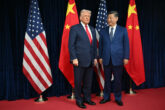July 20, 2018
Minding the Gap in US-ROK Public Opinion
The United States’ post-Singapore summit engagement with North Korea is in large measure being dictated by President Donald Trump’s perception of what Kim Jong Un agreed to behind closed doors. But whatever chasm exists between Trump and Kim’s understanding of what comprises a deal, the United States must navigate another serious gap between public opinion in its own country and in South Korea.
At home, Trump’s proclivity for salesmanship has compelled him to oversell his diplomatic feat — by suggesting that a potential deal, however laudable, is in the bag. His political line is affixed to the fact that he has been able to avert catastrophic war, thus making more concrete the possibility that the United States will be able to bring its troops home in the not-too-distant future. Trump’s breakthrough may pan out in the coming years, but for now, the real negotiations are only just beginning.
The broader point being missed here is that U.S. leadership must not just incentivize North Korea to follow through but also must mobilize allies and partners to stick with a common strategy as well. Trump is not simply a CEO — his preoccupation should not exclusively be the United States’ bottom line but ought to also encompass bringing allied countries’ views closer into alignment with our own.
Since Kim Jong Un’s January 1 peace address, and more markedly so after the first inter-Korean summit on April 27, there seems to be a growing disjuncture between the views of the American and South Korean publics on how to manage the Kim regime. This is noteworthy because negotiations with North Korea are not simply a two-way transaction. Rather, South Korean and other Asian audiences will view the way American policymakers manage and talk about negotiations with North Korea as a barometer of the United States’ willingness to be a leading force in the region.
American and South Korean leaders alike claim that the U.S.-ROK alliance is stronger than ever since it was formalized after the Korean War resulted in the 1953 Armistice. Yet, today, the gap between where American and South Korean people reside in their perceptions of the level of threat that North Korea poses is jarring. After a year of bellicose rhetoric and panic-inducing tensions, the April inter-Korean summit prompted a significant reappraisal amongst South Koreans of Kim’s intentions. A poll that South Korea’s MBC news station conducted in May 2018 found that more than 78 percent of South Koreans now view Kim as trustworthy. The second summit in late May did nothing to alter that overwhelming verdict on the North Korea leader.
Read the Full Article at The Diplomat
More from CNAS
-
Chinese Maker of Bitcoin-Mining Machines Is a Security Threat, Says Expert
Bloomberg News reports that a Chinese manufacturer, Bitmain Technologies Ltd, that sells most of the world’s Bitcoin-mining machines — including 16,000 of them to a venture ba...
By David Feith
-
Indo-Pacific Security / Energy, Economics & Security
North Korea’s Provocations, Power Plays, and Shifting AlliancesTensions on the Korean Peninsula have reached a new and dangerous threshold. President Lee Jae Myung is warning of a real risk of accidental military clashes, as the situation...
By Dr. Go Myong-Hyun
-
Indo-Pacific Security / Energy, Economics & Security
How to Win the Economic War with ChinaTrump's approach to China has run aground, giving Beijing unprecedented advantage in the economic conflict....
By Edward Fishman & Julian Gewirtz
-
Indo-Pacific Security / Technology & National Security
Sharper: Tech + ChinaRecent talks between President Donald Trump and Chinese Communist Party General Secretary Xi Jinping placed a spotlight on emerging technologies, from high-end chips to minera...
By Charles Horn & Sevi Silvia




